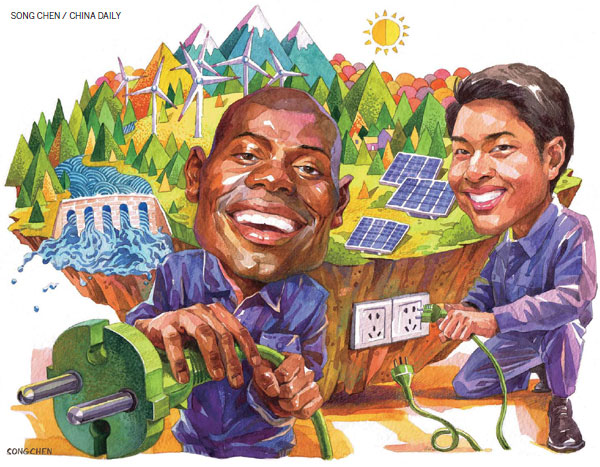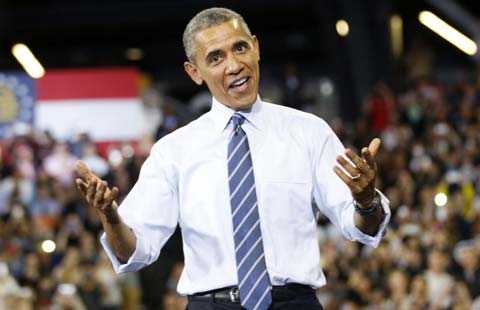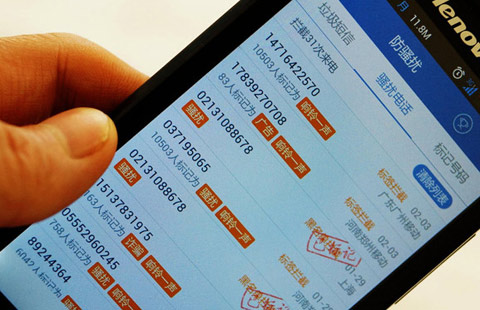
As Africa ramps up efforts to boost the use of renewable energy, China is playing a key role
China's record in infrastructure development puts it in a good position to play a greatly increased role in renewable energy projects in Africa. The continent is looking at renewable energy to significantly expand access to affordable energy to its citizens and to power industry. China, equipped particularly well because of its manufacturing base, price competitiveness and product innovation, is well placed to become Africa's biggest investor.
"China's foreign policy has enabled us to walk hand in hand in our quest to build roads and railways," says Mosad Elmissiry, head of energy for the New Partnership for Africa's Development, the implementation arm of the African Union.

|
A man runs past a wind power installation near Nairobi. Xinhua |
"This is an opportune time for them to help us bridge the existing energy gap."
Renewables now provide 17 percent of Africa's power.
Elmissiry says China has become a leading global investor in renewable energy infrastructure and is increasing its overseas investments, particularly in hydro, wind and solar.
"The country has amassed technical capability through its various global projects and, coupled with its investments in innovation, our continent will benefit immensely, particularly in costs and technology transfer."
Elmissiry was speaking on the sidelines of a two-day meeting in Nairobi to discuss Kenya's energy action plan.
Kenya is among 44 African countries that have committed to meet requirements set out by the United Nations Sustainable Energy for All initiative, headed by UN Secretary-General Ban Ki-moon, that call for universal access to modern energy services.
Assisted by the New Partnership for Africa's Development, Kenya became the second country after Gambia to make a concrete commitment to achieving global renewable goals set by the initiative. It drafted two documents that look at energy requirements and how these compare with the status quo, then drafted an action plan, and that has taken eight months. Once validation is done by participants including those drawn from the private sector, donor communities and energy experts from other African countries, resources will be mobilized and the project will be implemented. A total of $8.7 billion in funding is needed for all this.
|
Francis Njoka, a research assistant on renewable resources at Jomo Kenyatta University of Agriculture and Technology. Photos provided to China Daily |
Identified projects complement a master plan that the New Partnership for Africa's Development has outlined.
In July 2010, African leaders launched a new Program for Infrastructure Development in Africa that set out ways in which regional integration could be accelerated. Under the program, infrastructure is seen as pivotal in speeding up development and eradicating poverty.
The program, to which African leaders are giving high priority, has an energy component that includes 15 projects to be implemented by 2040.
Four energy transmission corridors have been earmarked to link all the power generation projects in Africa from north to south and from west to east.
The first corridor is from Egypt to South Africa, and the second is from Senegal to Djibouti. The central corridor stretches from Angola to South Africa and branches off to Cameroon then Chad. The North Africa corridor runs from Egypt to Libya, to Tunisia, Algeria and then to Morocco.
The network will enable countries that generate electricity at low cost to export their surplus to areas in need of energy so they can power their industries and homes.
In addition to the corridors, the continent has earmarked the construction of nine hydropower generation projects, a gas pipeline from Nigeria through Algeria and Niger to Europe and an oil pipeline from Kenya to Uganda.
"China's capacity in implementing various solutions is known," Elmissiry says. "In Africa it has implemented two hydro projects in Zimbabwe and a thermal project in Botswana."
However, some see the continent's resolve to pursue both fossil and clean energy as ambiguous. Francis Njoka, a research assistant on renewable resources at Jomo Kenyatta University of Agriculture and Technology in Kenya, says the continent needs to adopt a clear position.
"For a long time Africa has just been talking about green energy without tangible implementation strategies for this transformation. We are becoming poor in managing our natural resources instead of becoming the global beacon on renewable energy."
In line with the Program for Infrastructure Development in Africa, he believes that not all countries can be energy producers.
|
James Twesigye, head of the solar energy department, Rwandan Ministry of Infrastructure. Photos provided to China Daily |
"It will be more advantageous for Kenya to import power from Uganda or Ethiopia, which have massive and sustainable hydro power projects. Africa needs energy economists to enable it to map out its priority areas and maximize its resources."
But that plea may be a little too late as Kenya presses on with its power generation projects. In September 2013 the government launched an ambitious plan to add more than 5,000 megawatts to the national grid in three years. It aims to reduce power generating costs by almost 40 percent to facilitate industrial development and lift the country to the status of a middle-income economy.
Sixty-five percent of the country's people have no access to electricity, and more than 85 percent rely on traditional fuels such as wood, charcoal and agricultural residues for cooking and heating.
The country now has about 2,100 megawatts of installed power. Seventy percent of electricity production comes from hydro, geothermal, wind and cogeneration, and the balance is generated by thermal projects.
However, Njoka is uneasy about the energy mix.
"We don't know what we want," he says. "We don't trust ourselves."
Policies and regulations can only be well formulated if goals are clearly defined, he says.
"A culture needs to be inculcated to drive renewable innovation and uptake."
The continent lacks good policy formulation, people with technological know-how, land on which renewable-energy infrastructure can be built, proper regulations regarding incentives and the involvement of the private sector, he says.
Apart from government-led hydro and geothermal projects, private sector uptake in power generation has been low. At present, only three wind firms and two solar projects are being put in place, Kenya's Ministry of Energy and Petroleum in Kenya says.
Moreover, the private sector has often complained of the high outlays needed to set up renewable energy projects, the long time it takes government agencies to grant approvals and the dearth of local professionals to design such programs, which in turn means they must look to experts outside Africa who charge fees that they regard as exorbitant.
But Njoka dismisses these claims, saying his department produces post-graduate students for the job market.
"Because of high demand for their skills, most unfortunately do not complete these programs," says Njoka, who has a key role in program design.
However, Chinese companies are playing a useful role. Bartholomew Simiyu, the advisory director of Greenmillenia Energy Ltd, says Chinese companies have provided financial and technical support. GEL is among two private companies that have received government approval to develop a solar farm in Kenya.
The business says it spent about $1 million in the development stage, during which acquisition and feasibility studies were done in line with European Union standards, and a Chinese company provided technical skills that saved GEL about $250,000.
"This is costly and very strenuous for local developers," Simiyu says.
The 40 mW solar plant has received a generating license from the government after presenting technical, environmental and financial assessments, and it will start feeding into the national grid next year.
GEL is now negotiating with the electricity distributor Kenya Power on tariffs. But before sitting at the negotiating table, GEL had to obtain financing for the $86 million plant, and China's Export-Import Bank committed to this, with the African Development Bank expected to join later.
|
Demba Diop, senior consultant of EPM Consulting of the Netherlands. |
"We have received a lot of interest from Chinese companies such as Dongfang Electrical Corporation (of Chengdu, Sichuan province) and PowerChina (of Beijing), just to mention a few," Simiyu says.
"These organizations have talked with us, and we even have some agreements in place."
Kenya Power says it will agree to buy electricity from GEL once the company has presented the terms of its agreement with its financiers. It must also have the backing of the construction firm involved, the identity of which Simiyu said he could not disclose because the matter is confidential. The Chinese company has signed a deal under engineering, procurement and construction rules.
Under this agreement, the company would supply equipment and offer technology transfer.
China Exim Bank is providing 75 percent debt financing, and the rest is in equity.
The solar farm would reliably deliver power to the grid at a fixed price for a minimum of 20 years. Locals are also set to benefit from jobs being created.
The company, which also has operations in Uganda, Tanzania and Rwanda, is also working on additional wind and solar projects with other Chinese organizations such as China International Water & Electric Corporation.
"The backing of China is a key to the success of these projects," Simiyu says. Once completed, the project would significantly boost key government projects because the location is a strategic gateway between northern and southern Kenya, he says.
Another project that has received Chinese backing is Kenya Solar Energy Ltd, which is working on a 40 mW project on the Kenyan coast. It has signed an agreement with the power project specialist JS Neoplant of Hong Kong under engineering, procurement and construction rules.
This project is also earmarked to feed into the national grid by next year, and promises to significantly reduce the cost of energy nationwide. This is because coastal Lamu, where the project will be located, relies heavily on a thermal plant whose running costs are borne by all Kenyan consumers.
"It is very expensive, so Kenyans shoulder the expenses through the fuel adjustment costs in their bills," says Lee Alubala, an assistant technical officer with the country's Energy Regulatory Commission.
But with the commissioning of several renewable energy projects, Kenya is well on its way to achieving its goal of expanding access to energy at affordable prices. The government is ensuring that the cost of production is low, by offering incentives to the sector, including waiving import duties on solar panels.
But private investors have long complained that tariffs agreed on are very low, which means the return on investment stretches well into the future.
The policy was introduced in 2008 to promote the development of electricity generated from renewable energy resources and has been revised twice since, with a standard charge of $0.12 per kilowatt hour.
The government says this is necessary to keep down tariffs for consumers. The plus for investors is that the government commits to paying independent producers for more than 20 years, ensuring that there is a steady flow of income.
Once completed, the two plants will eclipse the size of others in East Africa. The biggest at the moment is Agahozo solar farm in Rwanda, with capacity of 8.5 mW.
The farm was built in just six months, and James Twesigye, head of the solar energy department of the Rwandan Ministry of Infrastructure, says the country saved greatly on costs by building and commissioning it so quickly.
The farm, built at a cost of $23.7 million by the Israeli company Gigawatt Global, has increased the country's electric capacity by 6 percent. The power purchase agreement is for 25 years and sees the country boost its capacity from 170 mW.
"It is helping to meet the demand we are facing at the moment," says Twesigye, adding that the ministry is in the process of negotiating for an additional 10 mW of solar energy.
China, which has been involved in offering power that does not rely on the power grid, did not submit a tender when initial bids were taken. "Maybe it is a lack of information."
The country is keen to increase solar production to 20 mW by the end of the year.
In Kenya the government is ramping up solar power production in rural areas as part of its Rural Electrification Master Plan. So far about 744 public places in isolated areas, from health centers to schools, have been hooked up to off-grid solar power through the initiative.
Five off-grid stations have been put in place, and investors are said to be enjoying rates of return of 20 percent. The operation is being expanded to build new plants and extend existing ones.
Gambia, the second country to launch an action plan, has relied heavily on private- sector participation.
"It was easy to mobilize the private sector to focus on investing in renewable energy because half of the country's power is thermal," says Demba Diop, senior consultant of EPM Consulting of the Netherlands, which helped compile the master plan.
lucymorangi@chinadaily.com.cn








